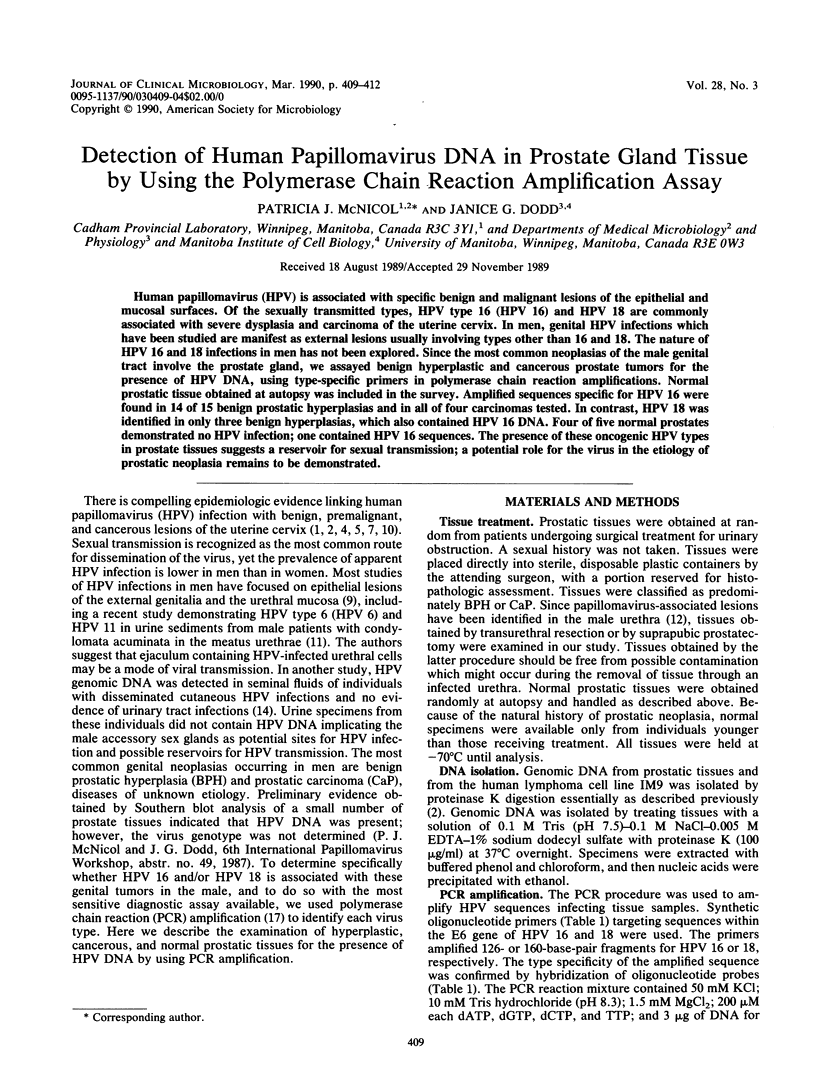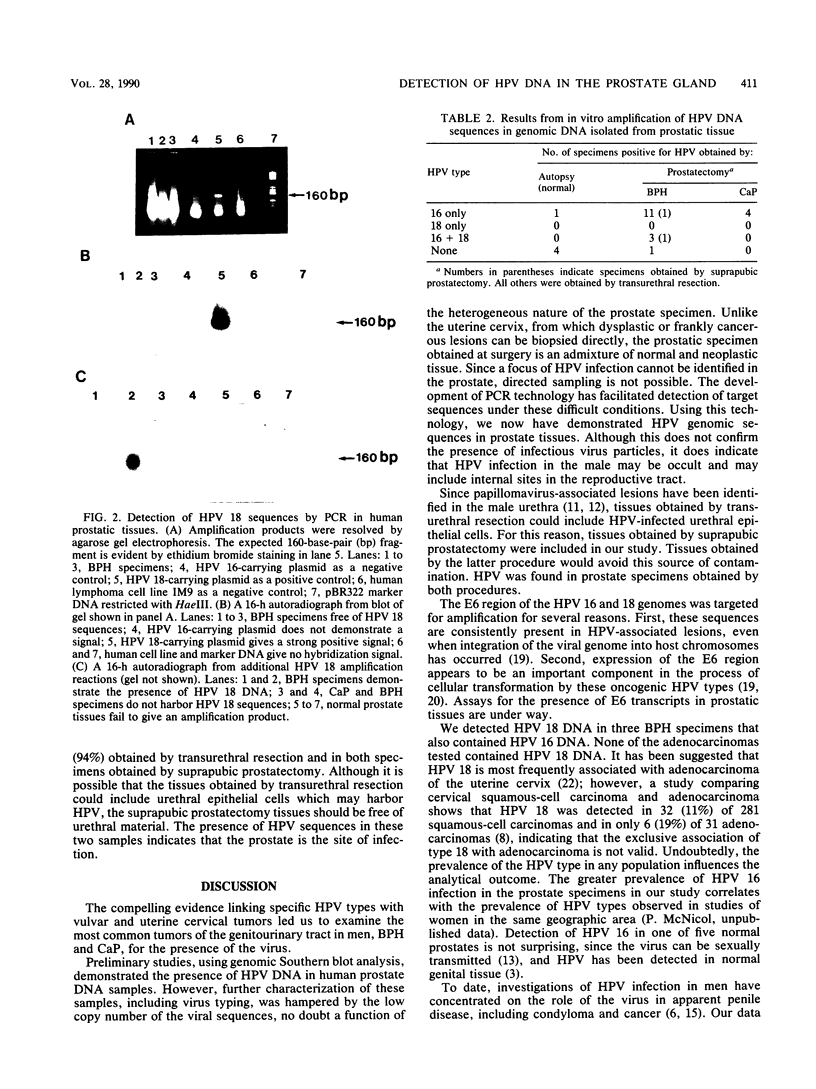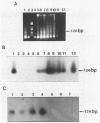Abstract
Human papillomavirus (HPV) is associated with specific benign and malignant lesions of the epithelial and mucosal surfaces. Of the sexually transmitted types, HPV type 16 (HPV 16) and HPV 18 are commonly associated with severe dysplasia and carcinoma of the uterine cervix. In men, genital HPV infections which have been studied are manifest as external lesions usually involving types other than 16 and 18. The nature of HPV 16 and 18 infections in men has not been explored. Since the most common neoplasias of the male genital tract involve the prostate gland, we assayed benign hyperplastic and cancerous prostate tumors for the presence of HPV DNA, using type-specific primers in polymerase chain reaction amplifications. Normal prostatic tissue obtained at autopsy was included in the survey. Amplified sequences specific for HPV 16 were found in 14 of 15 benign prostatic hyperplasias and in all of four carcinomas tested. In contrast, HPV 18 was identified in only three benign hyperplasias, which also contained HPV 16 DNA. Four of five normal prostates demonstrated no HPV infection; one contained HPV 16 sequences. The presence of these oncogenic HPV types in prostate tissues suggests a reservoir for sexual transmission; a potential role for the virus in the etiology of prostatic neoplasia remains to be demonstrated.
Full text
PDF



Images in this article
Selected References
These references are in PubMed. This may not be the complete list of references from this article.
- Beaudenon S., Kremsdorf D., Croissant O., Jablonska S., Wain-Hobson S., Orth G. A novel type of human papillomavirus associated with genital neoplasias. Nature. 1986 May 15;321(6067):246–249. doi: 10.1038/321246a0. [DOI] [PubMed] [Google Scholar]
- Boshart M., Gissmann L., Ikenberg H., Kleinheinz A., Scheurlen W., zur Hausen H. A new type of papillomavirus DNA, its presence in genital cancer biopsies and in cell lines derived from cervical cancer. EMBO J. 1984 May;3(5):1151–1157. doi: 10.1002/j.1460-2075.1984.tb01944.x. [DOI] [PMC free article] [PubMed] [Google Scholar]
- Dürst M., Gissmann L., Ikenberg H., zur Hausen H. A papillomavirus DNA from a cervical carcinoma and its prevalence in cancer biopsy samples from different geographic regions. Proc Natl Acad Sci U S A. 1983 Jun;80(12):3812–3815. doi: 10.1073/pnas.80.12.3812. [DOI] [PMC free article] [PubMed] [Google Scholar]
- Gissmann L., Wolnik L., Ikenberg H., Koldovsky U., Schnürch H. G., zur Hausen H. Human papillomavirus types 6 and 11 DNA sequences in genital and laryngeal papillomas and in some cervical cancers. Proc Natl Acad Sci U S A. 1983 Jan;80(2):560–563. doi: 10.1073/pnas.80.2.560. [DOI] [PMC free article] [PubMed] [Google Scholar]
- Hanash K. A., Furlow W. L., Utz D. C., Harrison E. G., Jr Carcinoma of the penis: a clinicopathologic study. J Urol. 1970 Aug;104(2):291–297. doi: 10.1016/s0022-5347(17)61721-x. [DOI] [PubMed] [Google Scholar]
- Kawashima M., Jablonska S., Favre M., Obalek S., Croissant O., Orth G. Characterization of a new type of human papillomavirus found in a lesion of Bowen's disease of the skin. J Virol. 1986 Feb;57(2):688–692. doi: 10.1128/jvi.57.2.688-692.1986. [DOI] [PMC free article] [PubMed] [Google Scholar]
- Koutsky L. A., Galloway D. A., Holmes K. K. Epidemiology of genital human papillomavirus infection. Epidemiol Rev. 1988;10:122–163. doi: 10.1093/oxfordjournals.epirev.a036020. [DOI] [PubMed] [Google Scholar]
- Levine R. U., Crum C. P., Herman E., Silvers D., Ferenczy A., Richart R. M. Cervical papillomavirus infection and intraepithelial neoplasia: a study of male sexual partners. Obstet Gynecol. 1984 Jul;64(1):16–20. [PubMed] [Google Scholar]
- Lorincz A. T., Lancaster W. D., Temple G. F. Cloning and characterization of the DNA of a new human papillomavirus from a woman with dysplasia of the uterine cervix. J Virol. 1986 Apr;58(1):225–229. doi: 10.1128/jvi.58.1.225-229.1986. [DOI] [PMC free article] [PubMed] [Google Scholar]
- Melchers W. J., Schift R., Stolz E., Lindeman J., Quint W. G. Human papillomavirus detection in urine samples from male patients by the polymerase chain reaction. J Clin Microbiol. 1989 Aug;27(8):1711–1714. doi: 10.1128/jcm.27.8.1711-1714.1989. [DOI] [PMC free article] [PubMed] [Google Scholar]
- Murphy W. M., Fu Y. S., Lancaster W. D., Jenson A. B. Papillomavirus structural antigens in condyloma acuminatum of the male urethra. J Urol. 1983 Jul;130(1):84–85. doi: 10.1016/s0022-5347(17)50968-4. [DOI] [PubMed] [Google Scholar]
- Ostrow R. S., Faras A. J. The molecular biology of human papillomaviruses and the pathogenesis of genital papillomas and neoplasms. Cancer Metastasis Rev. 1987;6(3):383–395. doi: 10.1007/BF00144271. [DOI] [PubMed] [Google Scholar]
- Ostrow R. S., Zachow K. R., Niimura M., Okagaki T., Muller S., Bender M., Faras A. J. Detection of papillomavirus DNA in human semen. Science. 1986 Feb 14;231(4739):731–733. doi: 10.1126/science.3003908. [DOI] [PubMed] [Google Scholar]
- Rosemberg S. K. Subclinical papilloma viral infection of male genitalia. Urology. 1985 Dec;26(6):554–557. doi: 10.1016/0090-4295(85)90359-0. [DOI] [PubMed] [Google Scholar]
- Saiki R. K., Scharf S., Faloona F., Mullis K. B., Horn G. T., Erlich H. A., Arnheim N. Enzymatic amplification of beta-globin genomic sequences and restriction site analysis for diagnosis of sickle cell anemia. Science. 1985 Dec 20;230(4732):1350–1354. doi: 10.1126/science.2999980. [DOI] [PubMed] [Google Scholar]
- Schuman L. M., Mandel J., Blackard C., Bauer H., Scarlett J., McHugh R. Epidemiologic study of prostatic cancer: preliminary report. Cancer Treat Rep. 1977 Mar-Apr;61(2):181–186. [PubMed] [Google Scholar]
- Smotkin D., Wettstein F. O. Transcription of human papillomavirus type 16 early genes in a cervical cancer and a cancer-derived cell line and identification of the E7 protein. Proc Natl Acad Sci U S A. 1986 Jul;83(13):4680–4684. doi: 10.1073/pnas.83.13.4680. [DOI] [PMC free article] [PubMed] [Google Scholar]
- Steele R., Lees R. E., Kraus A. S., Rao C. Sexual factors in the epidemiology of cancer of the prostate. J Chronic Dis. 1971 Jun;24(1):29–37. doi: 10.1016/0021-9681(71)90056-7. [DOI] [PubMed] [Google Scholar]
- Tase T., Okagaki T., Clark B. A., Manias D. A., Ostrow R. S., Twiggs L. B., Faras A. J. Human papillomavirus types and localization in adenocarcinoma and adenosquamous carcinoma of the uterine cervix: a study by in situ DNA hybridization. Cancer Res. 1988 Feb 15;48(4):993–998. [PubMed] [Google Scholar]
- de Villiers E. M., Wagner D., Schneider A., Wesch H., Miklaw H., Wahrendorf J., Papendick U., zur Hausen H. Human papillomavirus infections in women with and without abnormal cervical cytology. Lancet. 1987 Sep 26;2(8561):703–706. doi: 10.1016/s0140-6736(87)91072-5. [DOI] [PubMed] [Google Scholar]




